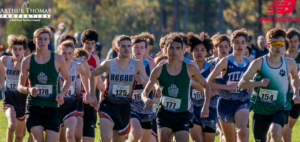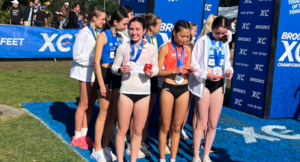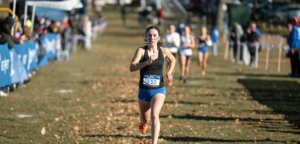Mimics and Mimes
“When I train or race,” my Dad likes to say, “I want it to be like a beautiful dream.” That is both a slice of advice and a pearl of wisdom. Maybe running is a simple sport once you are wise.  However, wisdom is acquired, not innate.
However, wisdom is acquired, not innate.
My Dad took me for my first long run in August after my sophomore year of high school. As has always been true, there was no advanced warning, although I imagine he must have been thinking about doing it for a while. So the build up to this big effort consisted of stopping the car on the side of the road a little over a dozen miles from our vacation destination. He got out and started rummaging around for his running shorts and his trainers. “Tristan and I are doing our run,” he announced to my mom.
After being blasted with a layer of Deep Woods Off thick enough that it reflected sunlight, we were suddenly running down an endless dirt logging road in ninety-five degree heat at two in the afternoon. Among the many fundamental truths that I learned that day, one of the most resonant was that if you are running when it is hot outside and you start to feel so cold you shiver, then it might be time to stop.
Another truth I learned is that Dad excelled at injecting spontaneous adversity (i.e. torture) into running whenever he pleased. He used to fall behind on runs and then turn onto a different trail without warning, leaving us to turn and sprint to catch back up. If my brothers or I ever stopped to go the bathroom on a run he would not only keep running, but start running faster and faster so we either had to sprint to get back up or spend the next mile grinding away to close the gap.
Grabbing the back of your shirt and pulling you backward was another prelude to one of his surges, he did this to me for years. Running into the bottom of a steep hill? Seems like a great time to grab the other guy’s shirt and pull them backward to get a head start into the climb! This persisted for years. In college, when I had teammates visiting for a few days he would join us, and do the same to them. The Bowdoin desire to beat Bates guys is carved deep into his competitive psyche.
Another favorite strategy was when he would talk about training with Joanie Benoit Samuelson. He described how when he ran with her they would always go right to 5:30 pace for twenty miles. Then he would start running 5:30 pace to demonstrate. He talked about how she would always go around every corner as wide as she could, so that she squeezed every last drop out of the training session. Then, while I was contemplating how much faster I would be if I did the same, he would cut the next corner of our run and accelerate away, holding sub-six minute pace until I scrambled back up to him, breathing so hard that it felt like the air was rushing in and out of my ears.
I tried this tactic on a run during a training run my freshman year in college. I told the same story, and then ducked the next corner. It worked beautifully, and I sped away to tag the door to Merrill first. Afterward I got royally reamed out by an unhappy upperclassmen. My stampede through the flower beds outside Muskie Archives was determined to be unsportsmanlike conduct. But to have that moment of satisfaction of pulling away from a guy who had spent the last forty-five minutes telling me that I wasn’t fast enough to be competitive in the 800m was a good feeling.
The worst runs were when Dad would start to get “tired.” All of a sudden I would notice that I was stronger than he was. I was not running, but gliding. Then I would start bounding up the hills in the woods. My newfound confidence would inspire a sense of freshness in me that I had not felt before. I realized, I was not just a good runner, but a great runner. It occurred to me that I finally had him under my thumb. Then I might just start to give it a little juice, increase the pace a little.
That is when the teeth of the bear trap hammered shut. Hooting like a howler monkey, pushing his head back in a mockery of true suffering, and complaining loudly about his asthma and how it, “wasn’t good breathing weather,” Dad would suddenly be on my shoulder just as we came out of the trees and back on to the roads. The battle had begun.
Running shoulder to shoulder, faster and faster, we would wind the pace up with each of us grinding out a six inch lead, until we were going full gas. This is before GPS watches so I don’t know how fast we were moving, but the hammer was so far down the sparks were flying as the steel bit at the pavement.
I would start to feel as if somebody had stuck an electric whisk inside my skull and flipped it to “foam.” It might have been a beautiful dream for him. But for me it was a complete nightmare. Gasping, burning, flailing down the road; I pushed myself forward. It was ecstasy. I have always liked finally forcing myself ahead at the end, and feeling the power of being able to push myself as hard as I could. There is something oddly satiating about flying over the road going faster and faster. It is a rush; you feel remarkably free. Some days suffering feels better than taking it easy.
 There’s a Nike commercial featuring a montage of Mo Farah that flows so fast it seems like it is strobing. Clip after clip of Mo doing different exercises fires on the screen. Even with the brief flashes of activity, the implications about the level of work, suffering, fatigue and self discipline are clear.
There’s a Nike commercial featuring a montage of Mo Farah that flows so fast it seems like it is strobing. Clip after clip of Mo doing different exercises fires on the screen. Even with the brief flashes of activity, the implications about the level of work, suffering, fatigue and self discipline are clear.
Mo Farah is a champion, maybe the champion of champions. Unlike many other multi-time world medalists, he has only set one world record mark, running an 8:03.4 for the indoor two mile. It is in racing for place where he really shined. Between the Olympics and World Championships, he has racked up ten gold medals and two silvers. It’s impressive that he won so much without becoming the fastest ever in his primary race distances. He knew how to race, and he new how to win when it counted most. So Mo must be somebody worth emulating.
But, I don’t know that the Nike commercial really tells us anything. I don’t even know that I would call that video a collection of actual training. Why is he at the bottom of twenty foot diving well jogging in place? That’s not a thing people do to win the 10,000m. It really just seems like a great way to drown! I haven’t tried, but I’m guessing that it must be hard to run fast if you have drowned.
It’s is still an awesome video. It has helped TRIBE as a key stepping stone in building our understanding of how to run. When we aren’t running well, and people are struggling to run to their potential in races, we watch this video. It shows us exactly what not to do. It doesn’t show how to train or how to race. The video is an adrenaline rush designed to tell a story that sells shoes. After we watch Nike’s commercial the next thing we do is look at a photograph. This is courtesy of my uncle, a former mountaineer and part-time wilderness photographer.
His image shows magnificent stillness and peace. It is more representative of running than any promotional mashed together by a shoe company. The essence of that landscape picture is the essence of what we are striving to create. We want to separate ourselves from the chaos and noise that seems everywhere and endless. We are trying to listen until we find something inside of us and stay focused on that. We want our minds to be completely empty as we run.
Finding your resonant frequency is key. There is no mind versus the body. They are one. The mind is the body, the body is the mind. They don’t converse with one another, they are fused together. Unfortunately, we tend to see these as separate, and then we see ourselves locked in a struggle as we seek to master ourselves. That creates the nightmare. To find our way in the dark, we look to find examples of runners that we believe have mastered themselves. Clearly, the fact that we are envious of their accomplishments, means that they know how to make their body do what they want it to do. If we try to become as much like them as possible, then we will achieve great success ourselves.
There have been many great runners and other endurance athletes. Most are forgotten by all, but their contemporaries and people with a deep memory. From the many high level performers, a few have stood out. Their example, or at least what people remember about their example, has profoundly guided the consensus on what works for running.
From Roger Bannister we gained the workout to end all workouts. Ten times a quarter mile with a minute rest. If you can do your times with a sixty seconds rest interval then the logic equation of interval training says you’ll do that for your one mile race. So we’re obsessed with running repeat quarters.
From Jim Ryun we learned that the runners who win will be those who are talented. Only the talented can achieve, because only the talented can truly imitate the training of other talented runners before them. Ironically, even though Ryun’s training is famously strenuous, he is used as an example of what not to do. I think the implication is that because he trained so hard in high school he was not successful as an international runner. I guess that Olympic Silver medal is somehow construed as being the result of a burnout high school phenom, not the culmination of an awesome racing career. There was a time when people were trying to emulate Coach Timmons and Jim Ryun, but we moved away from that over time because there wasn’t a burst of other sub four minute milers. We now say the first high school boy to break four minutes in the mile did X. So whatever you do, don’t do X.
From Seb Coe we learned to stop running so much. Why run to get better at running? Instead, we know to engineer everything we do with exacting specificity; running should be micromanaged. Peter Coe helped us fully realize that the stopwatch and a calculator are the keys to success. Training is more valuable as it becomes more measurable. So ideas like running for an hour in a comfortable steady effort was too vague, too general, too boring. There’s not enough space for coaching. Where is the opportunity for the coach to micro-manage?
The idea essentially emerged that the less a training modality called for a coach to plan, dictate, direct, and drive the athlete forward, the less valuable the training must be. Training needs to be totally based on the whims of the coach, the athlete himself has no valuable input. The coach needs to design because the athlete doesn’t know how to push themselves or control themselves. So, from Roger Bannister forward intervals and repetitions have moved more and more to king of the hill instead of a piece of the puzzle. Weight lifting has started to emerge as a close second because like intervals we can measure the number of pounds, use different carefully coached movements or freakish looking machinery.
But the number of athletes who are held up as exemplars are usually focused on because nobody talks about training like Steve Ovett. Why? Arguably (definitely, Dad says) Ovett was a better runner than Coe. If you don’t believe me watch his 1977 World Championship 1500m race. Ovett is so unbelievably dominant, so extraordinary smooth as he runs. He isn’t fighting his body to run sub sixty second laps. He isn’t struggling to get his legs to simply pump up to that tempo, it seems very natural. That’s probably why, with two hundred meters remaining, he just floated away from the rest of the field. It was such a dominant acceleration that John Walker, the first man to break 3:50 in the mile and the reigning Olympic Gold Medalist simply stopped, and walk of the track in shock.
Ovett said of his running that, “Sometimes I run and I don’t even feel the ground. I’m just drifting. Incredible feeling. All the agony and frustration, they’re all justified by one moment like that.” I think Ovett found something that the rest of us have not. And it’s something more than the ability to run a twenty-four second last two hundred at the end of a 1500m race. He seems to have tapped into a serenity that eludes most of us. He was running here but it was like he was also existing in another plane of existence.
Bannister, Ryun, and Coe and their methods became famous either because of the magnitude of their achievement captured broader media attention, or they forced themselves into the limelight over their contemporaries. The consequence is that even now you can find tons of materials on what these three and other standouts have done for their training. So the inevitable outcome is that we start imitating them. They are good, it makes sense to be like them. People like Ovett did not seek to cultivate a public image the way Coe did and he didn’t have a wave of media attention bearing down on him trying to drain him of his “special” training methods.
Each of us needs to decide for themselves if running has a soul. If it does, do people like Seb and Peter Coe take a piece of that away as they promoted their understanding of how to create success? Or did they enrich the soul of the sport? The number of elites that we hold as examples of what to do is a tiny percentage of the total number of elites over the years.
How would the landscape of training change if we looked at the training of all these others and not the select few. Would it be totally different than what we get from the few who were either seized upon by the media, or seized media for their own self-promotion? Maybe that’s where we can find the pieces of our soul that have gone missing over the years. World records are improving, and we’ve accumulated more and more exemplars to emulate, but is the average runner really any better than they were forty years ago?
When we try to apply the experiences of other runners to what we do ourselves we aren’t being runners anymore. We are just mimicking something that we aren’t because it represents something that we would like to be. When you imitate you are doing something that is not real. It is difficult, draining even, to constantly work to sustain the fiction that you are somebody else.
Mimes and dancers are performers, they seek to either imitate, emulate, or gesture at something that they aren’t themselves. In doing so they are experiencing a state of unreality. They are performing. There are external cues that they are emulating or following. The directions of a choreographer, the music of a composer. Maybe it is the dictates of a teacher, or simply their notion of how other people want something to look, how others, perhaps more expert than them have done it.
Eliud Kipchoge is the man. Now people are talking about whether or not he is the greatest of all time. It is hard to say, times make it so difficult to compare success. Is greatest a measure of speed, victory, dominance, consistency, or longevity?
I found a video of Kipchoge on Youtube. He’s in some sort of aerobics studio except it’s populated by world class distance runners in Nike and Adidas technical fiber t-shirts instead of fizzy haired people with thick socks, polyester leotards, and headbands. There is a constant pounding music and a mirrored wall.
In that loud room Kipchoge supposedly spends an hour going up and down between the floor and one of those broad plastic steps that are used to prop open doors during phys-ed class holding a five pound dumbbell in each hand. He just ran 2:01:39 for the marathon. Clearly this surprising routine must be what makes him so much better than the rest. That is what we need to bring into our own training plans to ascend to the ultimate level.
TRIBE will not be doing this, I can assure you. There will be no dumbells, plastic steps, mirrors, or loud music. There will certainly be no glossy baby blue and purple zebra striped leotards. If we are unwilling to imitate the great one, does that makes us close minded and ignorant? Does that mean that we are trapped in our own paradigm and are now incapable of thinking outside of the cardboard box fort that we’ve built up around us as we have made our own improvements?
There’s no absolute way to know for certain if the practices of certain runners are central, peripheral, or just irrelevant to any runners success. The best approach is so non-specific, it isn’t really fair to call it an approach. You want to try to look at the aggregate, but also measure it against your own, internal rhythms.
Kipchoge is a man of his own rhythm. It seems unnecessary to draw up a parallel to a philosopher, sensai, guru, or a transcendent. Kipchoge is impressive as Kiphcoge. People are going to be compared to him in the future and usually found lacking. He is soft-spoken, considerate in his speech, and masterful in his execution of all things running.
Even though the loud music bounces of the walls of the mirrored room, Kipchoge is moving to his internal rhythm, not the rhythm of the constructed environment around him. Kipchoge is oriented towards himself most. Hence his efficiency and his accomplishments. He is a true runner.
You cannot approach the fullest extent of your potential until you learn to listen to yourself. Runners may draw inspiration from others. They may be inspired by Seb Coe or Peter Snell, or Lasse Viren, or Jim Ryun, or Yifter the Shifter. They can imitate them, but only to an extent. Not one successful athlete has created their success by purely mimicking or miming another. You cannot be somebody else.
Marty Liquori said, “Road racing is rock ‘n’ roll, track is Carnegie Hall.” Liquori is dead wrong. All running is like jazz, it has its structure, its framework and its inspirations. Running is also free flowing and improvisational. Jazz follows its own rhythm of logic. The best runners learn to do the same in their racing, training, and lifestyle.
Running is a simple act of immense complexity. If you make different distances and environments of races into abstractions, then you are ignoring the rhythm. When you try to emulate others, you are moving further away from yourself. The champions became as they are, the possible versions of themselves, they found their rhythm, and they ran with it. Once you know your rhythm, you can bring out your best in any event. That doesn’t mean that there won’t be other people better than you, but you will always be successful no matter who beats you.
I suppose I should admit that my Dad helped me find my rhythm as a runner. All of those pranks and hi-jinks made the running so unpredictable, so inconsistent, that I had to focus on something that was internal and constant. I never knew how far or long we were running when we went out the door and it used to make me feel like I was exploding out of my head. When I first started running, I was just dragging myself to the end of each run like I was going hand over hand on a rope climb. But eventually I learned to relax. It didn’t matter how long it took me to catch back up or how hard we hammered. I let the tension out of my shoulders, I relaxed my face so that my teeth almost clacked together with each stride. I tuned into something inside of me and then the running just flowed. I turned the nightmare into a beautiful dream.
Now I have a switch that I can flip when I need to. It doesn’t make me particularly fast, or any less unremarkable as a runner. But on the occasion, my runners decide to show coach that he can’t hang, I simply flip the switch into the “on” position and tune into my rhythm and leave our sixteen and fifteen minute guys a little surprised that Coach can run.
TRIBE will seek to emulate Kipchoge. We are willing to derive inspiration from the achievements. But we will balance this with the recognition of the essential truth. The secret is there is no secret. Find your rhythm on your internal frequency, then turn up the radio and drive.
–Coach Bling
Matt Kraus
Race Rhythm is probably the most challenging part of racing for new cross country runners. I didn’t find my race rhythm until mid season last year at Festival of Champions at Belfast, Maine, cutting my time from 30 or more minutes to 27. I wasn’t fitter, I just ran the race with better rhythm. Your race rhythm defines how you race whether your rhythm is 10-minute pace or 5-minute pace.
To find your rhythm, you have to experience a 5K. You can’t take a rhythm for a one mile race and apply that to a 5K. To find your race rhythm you have to run one race at the pace you feel is right for the full distance. Then, depending on how you felt, you should increase the pace at which you run in the next race. Once you find a pace you feel that you can sustain for 3.1 miles, you will start to improve a lot. When you reach the finish line you should feel like you have emptied all the fuel from your system. That’s how you know you’ve found your race rhythm.
When I race. I feel like it’s just me and the course. I don’t care about other people’s “rhythms” I care what I’m doing during the race. My rhythm can’t be described clearly but when you race, you want to feel like your skipping along the course at higher speeds than the shuffle jog, but easier than a full out sprint.
Racing, in my opinion, is one of the best feelings in the world. Recently, I raced at NHTI and I felt amazing in the race. Smooth rhythm and I gradually increased my pace throughout the whole race. When you find your rhythm, you will run your best times. Ultimately, you can’t force your rhythm to happen, if you can be patient your rhythm will find you.
Eben Bragg
 Rhythm is one of the most important things in racing if not the most important. With a perfect rhythm you can essentially sustain the same pace throughout the whole race.
Rhythm is one of the most important things in racing if not the most important. With a perfect rhythm you can essentially sustain the same pace throughout the whole race.
The reason rhythm is so important is that if you don’t know your ideal race effort then you can go out too fast in a race and blow up. This is obviously really bad. When you hit the wall, no matter how fast your first mile was, you will not run to your potential.
The other scenario is if you start the race too slow which doesn’t happen often in cross-country but it can, then you might not be able to make up the time you gave away to your competition in the last one to two miles of the race. This is a fear I always have. I want to be sure that I don’t blow up in the last 1200 meters of the race. Fortunately, by running my rhythm I am able to make sure this doesn’t happen.
The thing many people don’t understand is that your race strategy is your rhythm. We often consider these to be separate from one another, but they really aren’t. With race strategy people worry about tapping into the drive to push yourself. People try to pit their desire to achieve against the physical fatigue that grows throughout the race.
It is difficult to explain. But I have found that I push myself hardest when I stop trying to push so hard. Ironically that’s what will allow you to running personal best, and hopefully some big times. My personal rhythm feels like I’m floating over the ground the ground. I focus on my arms more than I do my legs. Typically when people start dying off or become tired during the race their arms start to tighten up first. This shouldn’t happen since you’re not using those muscles to run, but if they do work as a metronome. If I focus on my arms then I can keep my momentum and gradually increase my speed.
Rhythm is not just for racing. It is key to good training. When you train you to need to always stay relaxed – never go one hundred percent in workouts or regular runs. Avoid using your race rhythm in training. Although the rhythm is different during training, you still need to be composed and calm at all times. Then, in the race, you can call upon that same calm and composure to carry you through the short burst of intensity between starting and finishing. Rhythm is what allows running to be such a satisfying challenge.











